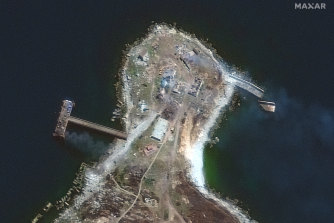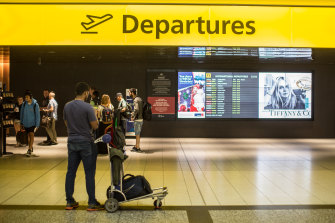Key posts
- Russian forces leave Snake Island, keep up eastern assault
- Falling population to cost NSW and Victoria cash and possibly seats in parliament
1 of 1
Russian forces leave Snake Island, keep up eastern assault
Sloviansk: Russian forces withdrew from a strategic Black Sea island on Thursday (AEST), potentially easing the threat to the vital Ukrainian port city of Odesa, but kept up their push to encircle the last stronghold of resistance in the eastern province of Luhansk.
The Kremlin portrayed the pullout from Snake Island as a “goodwill gesture”. But Ukraine’s military claimed it had forced the Russians to flee in two small speedboats following a barrage of Ukrainian artillery and missile strikes. The exact number of troops was not disclosed.
This image shows a burning pier and buildings on the northern end of Snake Island, in the Black Sea, on Thursday.Credit:Maxar Technologies via AP
“Unable to withstand the impact of our artillery, missile and aviation units, the Russian occupiers have left Snake Island. The Odesa region is completely liberated,” the General Staff of the Armed Forces of Ukraine said in its regular social media update.
A senior Ukrainian military official, Oleksiy Gromov, earlier said Kyiv was planning to deploy troops to Snake Island, but did not specify a timeline.
“At the moment, we control [the island] with the help of our weapons: long-range artillery, rocket units and aviation,” Gromov said.
AP
Falling population to cost NSW and Victoria cash and possibly seats in parliament
Victoria and NSW will pay a huge economic and political price for the COVID pandemic, losing potentially hundreds of millions of dollars worth of GST and seats in parliament to other parts of the country.
New population estimates for the nation’s two largest states which show a “shortfall” of 101,000 Victorians and 95,000 people across NSW pave the way for a re-jig of the $79 billion GST pool and a loss of federal representation.
More than 100,000 residents have left Melbourne in recent years.Credit:Scott McNaughton
If Victoria does not turn around the population crash it suffered through COVID, it could lose an unprecedented two federal electorates in boundary redistributions, while NSW is on track to lose one. Western Australia could reclaim the electorate it lost before the 2021 election as well as millions in additional GST payments.
The Australian Bureau of Statistics this week released the 2021 census. That information was used to update the nation’s estimated population as at June last year at 25.6 million. This was 50,000 lower than the bureau had expected when it last updated its forecasts.
Read the full article here.
This morning’s headlines at a glance
Good morning and thanks for your company.
It’s Friday, July 1. I’m Ashleigh McMillan and I’ll be anchoring our live coverage for the first half of the day.
Here’s what you need to know before we get started.
- Australia will be exposed to sanctions for missing climate change targets under a new trade deal with the European Union that holds out the promise of boosting $94 billion in two-way trade.
- Sydney’s train network will be thrown into chaos on Friday after the rail union warned the NSW government’s sensational backdown over the future of a new train fleet was not enough to call off widespread industrial action.
- Victoria and NSW will pay a huge economic and political price for the COVID pandemic, losing potentially hundreds of millions of dollars worth of GST and seats in parliament to other parts of the country.
- Russian forces withdrew from a strategic Black Sea island on Thursday (AEST), potentially easing the threat to the vital Ukrainian port city of Odesa, but kept up their push to encircle the last stronghold of resistance in the eastern province of Luhansk.
The NSW State Emergency Service faces accusations of failing to plan for a catastrophic flood in Lismore and the wider Northern Rivers, despite decades-old research warning such a disaster was probable.
1 of 1
Most Viewed in National
Source: Read Full Article

